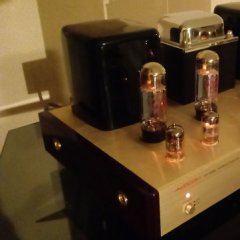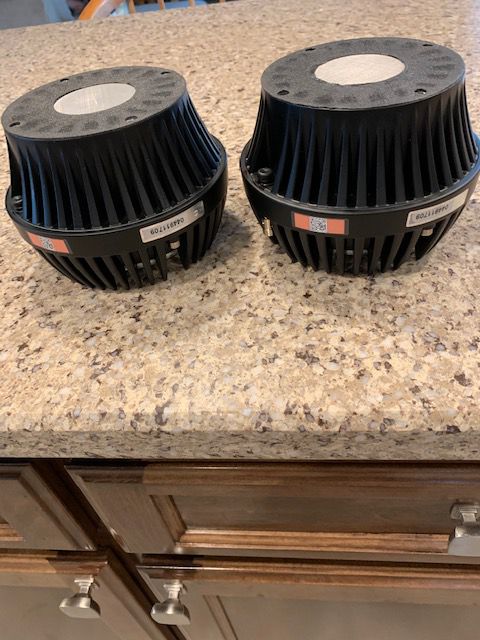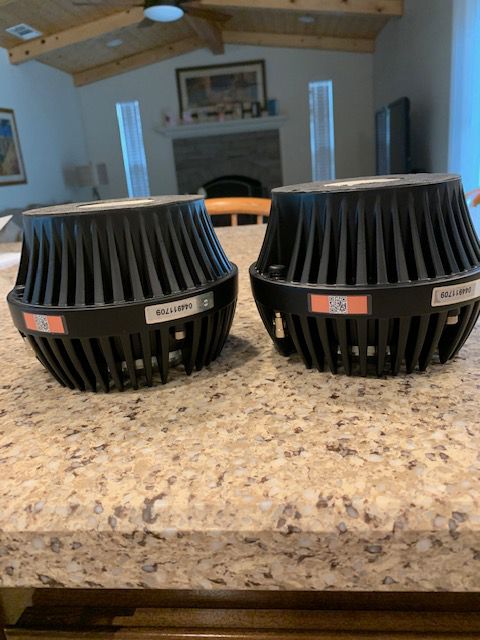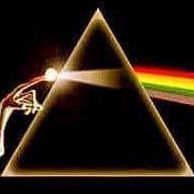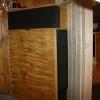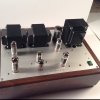Search the Community
Showing results for 'dcm50'.
-
I've been struggling to settle on horn/driver combinations to use atop my pair of sealed Altec 416-8B midwoofers. The most likely candidates are SB Audience 65 CDNT, Yamaha JA6681B, B&C DCM50 and Radian 745neoBe. Regarding the DCM50, I seen posts such as here https://www.audiocircle.com/index.php?topic=169189.0 https://community.klipsch.com/index.php?/search/&q="dcm50" &quick=1&search_and_or=and&sortby=relevancy ,where it seems as if others like me also have struggled with the dilemma of owning or wanting the benefits of high res horn speakers but troubled over how your less than pristine recordings will sound on them. Indeed, so many of my treasured 60s pop and soundtrack music-many of which otherwise respectably recorded (fairly low noise and distortion)-were then deliberately mastered with lots of compression. No doubt this was done to make them playable on cheap vinyl players, or even the SOTA turntables of the day. But in Troy Crowe's review of these drivers, please take time to watch this video entirely from 17:15 to the end. Notice that during his listening test ratings, Troy gives the DMC50 a less than 10/10 rating for dynamic range. My question is would the B&C DMC50 be a much better choice for playing our over compressed recordings than one with more higher sensitivity, and thus more dynamic range, such as the Radian 745neoBE? Comparing basic specs: https://www.bcspeakers.com/en/products/hf-driver/archive/dcm50-8 https://www.usspeaker.com/radian 745neoBepb-1.htm And might the DCM50 also be a better choice for playing compressed recordings because it uses a "composite" or paper diaphragm, rather than a beryllium one, like the 745neoBE?
-
To spite the chance if being accused of abusing the form, I am going to share this with the group. Yes, I may be offering this driver and a new 2-inch horn if everything works out as I hope. For now however, it is simply a suggestion. Ever since I can remember there has been an interest in upgrading the K55 driver in the Khorn. The problem has been finding one that is actually designed to go down to 400 Hz and survive. There are simply none in a 1-inch horn format that will do! This means we need to move to a 2-inch throat horn. Even in 2-inch there are not may drivers that will do. Most are designed to be crossed over at 800 Hz or higher. After finally getting it through my thick skull that I simply have to go 2-inch, I started looking for a suitable driver. I think I have found one. It’s the B&C DCM50. This driver is not the typical driver with a metal or phenolic diaphragm. It’s a “composite”. I think that’s like the “paper” cones you see on direct radiator drivers. I took a picture looking through the bug screen as best as I could. That picture is below. The lines you see radiating out from the cone in the center are actually supports. The diaphragm is farther back and can’t be seen. I don’t have a 2-inch horn to evaluate the driver properly yet, I will be getting the prototype Trachorn 420 horns from Bill Martinelli in about a week. For now, I can at least do a preliminary introduction.
-
Could not find what I was looking for using the search function and I have no means to measure it so I have to approach it in this manner. For purposes of tap settings on the autoformer, what would you guess the sensitivity of the DCM50 to be "on the horn"? I believe the sensitivity of the driver alone to be 108.5db if I am not mistaken. I am using 0-4 on the 3636 now for -3.0 db. I know what I like and have been experimenting but wanted to hear some additional thoughts.
-
B&C DCM50: Best Horn Driver for Compressed Recordings?
oltng replied to oltng's topic in Technical/Restorations
Thanks all for replying. But why wasn't I notified via email? I was sure that I checked to be so. While Troy does rate drivers by measurements, and is very thorough about doing so, as I said, if you watch and listen to the above video from 17:15 to the end you will find Troy's LISTENING tests. And note where he then rates the sound of the DCM50's dynamic range 9/10 or 8/10 below that of the other drivers. That's what got me thinking that unlike, say Pierre's superb but way more dynamic speakers (posts 15266, 15276), the DCM50 would therefore make my compressed recordings sound less compressed. True or false? And if true, would that still be so even if, like Troy did, I added that Fostex Alnico tweeter? -
Hi Emil, Please excuse the off topic request but I'm new here and bumped into you at audiocircle while searching for current or former users of the B&C DCM50. https://www.audiocircle.com/index.php?action=pm;f=sent#msg925359 Please share your experiences. Everyone here welcome to chime in too!
-
The B&C DCM50. Can it replace the K55 driver?
oltng replied to Al Klappenberger's topic in Technical/Restorations
Really need to discuss the DCM50 vs other drivers-especially drivers like the Radian 745neoBe for my build. Please reply everyone! -
G’day all. Yet another prospective Cornscala builder with need for advice. After lusting over Cornwall iv’s for some time I could not justify spending AUD 18000.00 approx. 14000 US on a pair here in Australia so have decided to go the diy route. After a lot of poking around here on the forum I’ve ordered some ALK sp12 and es5800 networks, Crites cast frame woofers, B&C DCM50’s, DE120’s and eliptrac 400 with Dave’s tweeter horn. I initially was going to go with the C type Crites kit but was told that they have had huge problems in the past with freight companies in the past damaging orders etc when shipping to Oz. So that led me down a rabbit hole to purchasing the parts mentioned above. So my question/plea for help is about the cabinets. I would prefer to build split cab speakers as some have done but am not sure of the cabinet volume size and port shelves. I am intending to brace the cabs, but not too heavily. I was thinking of using 32mm MR MDF as I will probably paint the cabs professionally.(vehicle refinisher by trade). I am not opposed to using ply, just a little harder to get really nice material here in Perth. If anyone has any cabinet plans or advice it would be very welcome. I understand that building split cabs with mdf will probably change the character of the speakers, if there is any one who has had success or failed with building something similar please chime in, any advice would be hugely appreciated. Once finished the speakers will be living in a large room about 560 sq ft. With 18 ft vaulted ceilings so space is not a limiting factor. Gerome.
-
I was planning to do a Cornscala build but have shifted gears. The following parts are up for grabs. The woofers and midrange are open box and never hooked up. The tweeters were run in my K-Horns for about 2 years but work perfect. The Eliptrac 400 was a flatpack kit from Dave that I glued/pinned/clamped but never got further. Crites Cast Woofers - $300/pair SOLD! Eliptrac HF w/B&C DE10-8's - $200/pair SOLD! Eliptrac 400 horns - $300/pair SOLD! B&C DCM50-8 drivers - $900/pair SOLD! Located in Holland, MI.
-
I played with a pair of B&C DCM50 2" Neodymium Midrange Compression Drivers in place of the KT 1133HP on the mid horns over the last few days. They have a natural sound to them that is very pleasing and detailed. But their mid range did not sound as full as the KT 1133HP. I am tickled to death with the performance of the KT 1133HP after these comparisons. So i'm going to stop trying to reinvent the wheel. Sending the B&C DCM50 2" Neodymium Midrange Compression Drivers back on Monday. I damaged the connectors to one of my KT-1133 HP drivers in my zest to try out the Celestion Axi 2050 drivers last week. Can anyone tell me if I buy a new diaphragm will it come with new spring loaded connectors? Or am I better off buying a new KT 1133HP driver?
-
Just curious if anyone here has used both of these drivers. I would like to know your opinions in a 3way setup.
-
For those like myself, who've had the privilege of owning some of the 1950's examples of the Klipschorn - with massive Stephens and EV Alnico woofers, 6x13 slot motorboards and wood/fiberglass K5J midrange horns with University SAHF drivers, there's always been an interest in knowing whether any performance differences exist between these early models and Klipschorns produced later in their evolution. Among the many questions, some, including myself, have always wondered: - Do the early Klipschorn bass bins with the original 6x13 throat slot and massive Alnico magnet woofers perform "better"? - Is the K400/401 a "better" midrange horn than the original final K5J? A couple of years ago I mentioned on the forum my intention to take a shot at investigating the different Klipschorn woofers and motorboards, but life got in the way and it wasn't until recently that I was able to devote the time and energy to getting that done. I've gotten a lot out of the Klipsch community over the years with a lot of help from guys with names like Al, Bob, Dave, Dean, Gil, John, Larry, Roger and many more, so here's my attempt at contributing something back. I'm not selling anything nor am I affiliated with anyone who is in the Klipsch world. Nor am I an expert at speaker measurement, and I can't claim to have golden ears. With that said, here is my report: Project Goal To measure the performance difference, if any, between various Klipschorn woofers (EV 15wk, k-33e square magnet, Crites cast replacement), Klipschorn motorboards (3x13 vs. 6x13), and the Klipschorn midrange horns (K5J vs. K400/401) and midrange drivers (University SAHF vs. K55v, m, v dual plug). Methodology To conduct the tests I: - Assembled the woofers, midrange drivers and midrange horns along with several crossover networks and woofer inductors - Made several Baltic birch motorboards with both 3x13 and 6x13 slots in 3/4", 5/8" and 3/8" thickness - master template cut for exact match and dry fit marked for exact throat aligment - Setup a 1950's Klipschorn base with a 6x13 slot bin - to accommodate 3x13 and 6x13 motorboards - in a properly sealed corner - Marked exact Klipschorn position to the corner with blue painters tape enabling exact repeat position as woofers and motorboards are changed - Setup a mic stand on center axis approximately 8ft from the Klipschorn - Umik-1 USB mic aimed at speaker with height aligned to the midrange center - Calibrated Umik-1 USB mic attached to laptop running REW measurement software with calibration file, connected to preamp system with testing volume uniformly locked at ~78db, preamp set on mono - Testing then conducted with double sound sweeps in identical conditions - All output set to 1/12 smoothing Importantly, the methodology used here is aimed at measuring the relative performance between components and not absolute performance. My experience has taught me that room conditions are the biggest factor involved, making absolute "reference" measurements far more complex than what has been done here, but these side by side comparisons have all been conducted in identical conditions and should have some validity. I will attempt to keep my comments on the results to a minimum. I'll start with the woofer/slot results first, and add the rest in the next day or two. Woofer Results IMHO, the performance turned in by the 62yr old EV 15wk woofer is impressive. One has to wonder what the measurements would look like with a brand new one in 1955. It's probably fair to say that with age, it's free air resonance is now closer to 40hz + , as opposed to the EV reference of 29hz when new. In my mind, the absolute performance of a Klipschorn bass bin in the 1950's has always been somewhat murky, with the occasional marketing pamphlet reference to full efficiency down to 36hz, and "excellent efficiency down to 30hz." But if the more modern Klipschorn bass bin has a sensitivity of 104db/1 watt/ 4ft,( or 105db/1 meter), do the Ev 15wk measurements here suggest that the old Klipschorn 6x13 bass bin with the large Alnico magnet woofers was a db or two more sensitive? In any event, it would appear that there are significant differences in the mid bass region performance. Is any of it noticeable to the ear and body? In my opinion, yes. Note: All measurements show a consistent 10-12db gap down at about 80hz due to room/furniture interference. It's ugly, but artificial. The rest is more or less in line with the general frequency response exhibited by the Klipschorn. In all cases, the k-33e and Crites cast woofer appear to measure slightly (1-2db) better in the 35hz region. Could the Ev 15wk's apparent disadvantage in the ultra low end be due to some deterioration in cone resonance due to age? The Crites cast woofer appears to improve performance over the k-33e in the 250-400hz region. Somebody knows what their doing. As expected and documented by Dr. Bruce Edgar years ago, the 6x13 slot threat presents difficulties for the newer woofers above 300hz. When using the EV 15wk in their own versions of the folded cornerhorn, EV specified a woofer inductor in the 2.8-3.0mh range. Depending upon the crossover point to the midrange, IMHO, the EV 15wk measures AND sounds good in the Klipschorn with inductors from 2.5mh to 3.0mh. In my opinion, room acoustics and personal tastes are the real determinants here. The internal 6x13 Klipschorn chamber without woofer and motorboard. Raw Klipschorn bass cabinet sealed into corner with gaskets and a custom made plywood corner backer board. The k-33e woofer installed: The Crites cast woofer installed: The EV 15wk Alnico woofer installed. I'm getting too old to be down on my hands and knees wrestling a 45lb woofer into position! Midrange Tests Here's a couple of pics I took of the assembled midrange horns, drivers and crossovers used, along with the midrange platform boards I built to easily change out the entire top section from one horn to the next. Because of the general interest in the more recent wood midrange tractrix designs for use with the Klipschorn, I've included some testing and comparison with the Volti FC260 2" throat tractrix horn using the B&C DCM50 8ohm driver. Midrange Test Results Comparisons of the K5J and K401 horns - using any of the k55 drivers, with and without networks, show a great similarity to the tests done by Paul Klipsch when introducing the "new" k400 in the early 1960's. Originally, the K5J was crossed to the tweeter at approximately 5000hz. The rough response of the K5J above 3000hz seems to illustrate why. After discussing PWK's results with several forum members in the past, it was generally agreed that while using the k55, the K5J was about 2db softer over most of its range vs. the k400. Thus, I asked Bob Crites to make a modified "a" network with -1db attenuation for use with the K5J, vs. the -3db mid attenuation used with the standard "a" network used with the K400. This brings the sensitivity back in line with the woofer and provides a better apples to apples comparison between the horns. Now it's easier to see that while the K5J is weaker on the higher end, it has some real punch in its lower range. More, tests reveal the subtle trade-offs between the k55v and k55m on the K5J horn. The k55m is usually a db or so "hotter" than the k55v in my experience, but not across the entire range and the plus/minus tradeoff is different with this horn, than with the k400/401. For those who've always wanted to see how the University SAHF driver (originally paired with the K5J) compares to the standard k55v on the K5J here is the result: SAHF compared to k55v on the K5J with the -1db mid attenuation network. Interestingly, the SAHF has more strength under 300hz than the k-55 - which has always been lauded for what few midrange drivers can do - its ability to reach down low. The SAHF also has a smoother exit response from 4000hz on, but the prominent dip between 1000-2000hz bothers me a bit. As far as the sound, my apologies, but I have spent zero time listening to the SAHF. The highly regarded K55v DUAL PLUG driver shows an interesting contrast to the k55m on the K5J. Some would say, and my personal experience agrees, that the K55v dual plug driver gives up a tad bit of sensitivity in favor of a smoother and more general extended response all the way to the promised 6000hz on the k400/401. It appears to help quite a bit here with the K5J as well. Moreover, it would probably be correct to adjust the midrange attenuation to 0 with this driver when paired with the K5J and thus delivering the best K5J/k55 performance possible, and a decent shot at using a 6000hz high frequency crossover point. Of course there may be even more K5J performance with John Allen's new A-55G mid driver, which I have yet to try. As far as the sound, they are definitely different and I greatly prefer the K5J to the k400, even with a 6000hz crossover, but I believe that personal preference and room acoustics would have a big impact on the voting. For those interested in the midrange "upgrade" path, here are the results comparing the Volti FC260 with B&C DCM driver, to the stock K400/401 and k55 setup. With a -7db attenuation setting used below, the Volti/dcm50 combination is close in sensitivity to the k401/k55m. It looks to me like a -6db attenuation setting would be an even better match, maybe -5db when paired with a Stephens or EV Alnico woofer with the 6x13 throat. The B&C DCM50 driver rolls off naturally on the FC260 around 9500hz. In this case, the custom network used here utilized a .15mh inductor in a 1st order midrange bandpass that begins the roll off at about 7500hz. IMHO, the FC260 sound is fantastic to my ears, and at a minimum, offers an alternative sound to the K400/401. Measurement and sound are two very different things, and I've never seen and heard a better example than this particular comparison - where the measurements look so close, but the sound is miles apart. Woofer & Midrange Combination Tests For those interested in how the combination of woofer and midrange measured in the tests, I compared the EV 15wk 6x13 with Volti midrange against the Crites 3x13 setup with k401/K55v dual plug midrange below. Tweeter was connected on the k401 setup, helping over 5000hz. I'll leave it to others to judge if the measured difference between 100-600hz is significant/meaningful/worthwhile. Here's the EV/Volti combination compared to the Crites 3x13 in combination with Volti/DCM50 midrange: If you have a newer Klipschorn after 1962 with the 3x13 slot, or you can't find or have blown your Stephens or EV15wk for your early 6x13 Klipschorn, here's a look at the Crites and Volti combination on either the 3x13 or 6x13 slot motorboards. When I have more time in the next few days, I will finish this post with: - Comparison between 6x13 EV 15wk/k5J setup and the 3x13 K-33e/k401 woofer & midrange setup - Comparison of motorboard thickness - 3/4", 5/8", 3/8", impact on bass bin performance
- 15 replies
-
- 4
-

-
- klipschorn
- ev 15wk
-
(and 3 more)
Tagged with:
-
Way at the top, I asked that you send me a PM or email. 33uF is roughly 600Hz, which at least gets you above the Fc of the horn. You can buy them any place that sells capacitors. If you want the same type capacitor, just read the label. The 2.5mH is the same value the Type B uses, so you know it's occupying some of that same space around 600Hz. The Universal isn't as "universal" as everyone thinks it is. It was designed to be used with the K-55 and K-400/K-500. It was called "universal" because it could be used in the Klipschorn, La Scala, and Belle Klipsch. The K-400 has an Fc that is almost a full octave below the crossover point (280Hz). It can be tweaked to be used in the Cornwall or Heresy. It wasn't designed to support any and all driver/horn combinations. Kevin, and some others can get away with it because they are using larger horns that have a lower Fc in combination with something like the BMS or B&C DCM50 that are designed to go low. ZXPC provides no real useable data on that horn. Without measuring, there is simply no way of knowing what is going on with that network/horn/driver combination. 33uF will probably prevent the diaphragm from hitting the phase plug, but as far frequency response, distortion, etc., - who knows.
-
Selling off some items as follows: B&C DCM 50 midrange drivers....$500 pr. Volti VTK 400 crossovers....$550 pr Beyma CP25 tweeters....$150 pair Wooden Edgar Tractrix horns w/tweeter mounts....$350 Klipsch MWM double bass bins w/4 k43 drivers installed....$500 or all listed Upgrade parts in a package(not MWM's) for $1500. I will send pics via text for those interested. Great sounding upgrades and I think I have these items prices very fairly. I have used these upgrades on my Klipschorns, Lascalas and other bins including MWM.s I am in Watertown NY area.....Thanks
-
Hi guys, New here. Have been tweaking my La Scala the last few months. Bought soldered lig version K55v, replaced the mid horn with Azura Le Cleac'h flare round, tweeter replaced by B&C DE120 with a cheap PRV tractrix waveguide (us$8 each on Parts Express). I made a new Type A crossover using russian K75-10 pio capacitors. I am curious about a better mid driver, and have been thinking about the B&C DCM50. My listening space isn't very big, neither do I listen to very loud volume in most instances, so I guess the DCM50 should still be ok, although I may make another crossover similar to AlK's Universal or John Albright's DHAX2. My question is: should I get the 16ohm or 8ohm version? For example, in the Universal there is a 10ohm resistor across the autoformer which I think is to flatten the 16ohm (of k55) to something around 8ohm, and this necessitates a change of high pass capacitance from Type A's 13uf to 48uf. So If I get a 8ohm DCM50, the 48uf would not be correct and need to be adjusted. I am hoping someone can throw a torch here. Thanks
-
As title states. Good/like new condition if possible. PM me. Thanks.
-
As the title states. Thanks.
-
A member of this forum emailed this plot to me. It's a measured response of the B&C DCM50, a JBL and the K55M taken by a supplier that markets the B&C driver (the middle plot in the attached). The B&C DCM50 appears to exhibit a dip in the response consistent with what I measured in the units I have here. There are a few years of production separating the plot of the B&C below and the ones I have (about 6) indicating that this "anomaly" is, in fact, the actual response of the driver. Given the enormous popularity of this driver, it suggests that this response, as Shakespeare would say, is much ado about nothing.... So Kudos to DrWho.
-
I just purchased a pair of Dave Harris's 400 horns and a pair of his tweeter lenses. I want to build a three way CornScala. For years I have always wanted to here a Cornscala so it will happen soon LOL. I have a new pair of Crites Cast frames that never got used from another project. I want to use the DE10 for the tweeter or maybe DaveAs tweeter lenses? I am leaning towards a pair of A55gs for the midrange with the adapter. Would the DE750 or the DE85TN be a better driver for the midrange? I Have heard the DCM 50 is a even better driver Is the DCM50 a big improvement over the other drivers I have mentioned? Maybe I need to spend the extra money and buy the DCM50? The reason I wanted to use the A55g is maybe to try and get the midranges to sound like a LaScala? I had LaScalla IIs for 11 years I liked the midrange of the speaker. Maybe it would not even sound like the midrange of the LaScala II using the Fastrack horn? As you can see I have a lot of questions I need help from my forum friends for this build Thanks Rich
-
Brand new B&C DCM50s. (1pair) These were used in a new set of speakers. The Owner also bought BMS 4592mids and decided the the BMS were what he wanted. Selling off at well below list. Normally $350 each. Justin 323-868-9722.
-

Crites Cornscala B/ B&C DCM50/ SuperX xover. $2K Long Island, NY
EmilC posted a topic in Garage Sale
PIcs and info can be found here: https://community.klipsch.com/index.php?/topic/155029-deans-superx/?hl=superx Located 60-90 minutes from GW Bridge, Midtown Tunnel or Throgs Neck Bridge -
I was just searching for B&C DCM50 and ran into partsexpress. they got a good promotion for this driver. the original price is ~650USD but they are letting them go for 391USD! thought someone might need a pair. maybe it's an old news, I don't know. http://www.parts-express.com/bc-dcm50-2-neodymium-midrange-compression-driver-8-ohm-4-bolt--294-5907
-
There are quite a few that people are using that are 8 ohms. The Selenium D405 and B&C DCM50 immediately come to mind.
-
Hahaha, you always have something Kevin. What else do you have? The DCM50 won’t fit in my cabinets with my current horns. What your opinion between the 50’s and bc85 drivers sonically to your ear?










